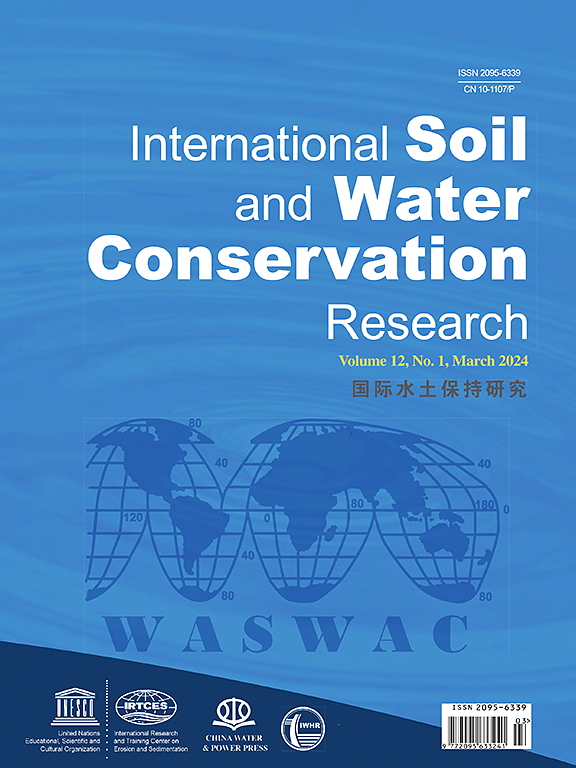Prediction and mapping of soil organic carbon in the Bosten Lake oasis based on Sentinel-2 data and environmental variables
IF 7.3
1区 农林科学
Q1 ENVIRONMENTAL SCIENCES
International Soil and Water Conservation Research
Pub Date : 2024-12-26
DOI:10.1016/j.iswcr.2024.12.002
引用次数: 0
Abstract
Soil is the largest carbon pool on the Earth's surface. With the application of remote sensing technology, Soil Organic Carbon (SOC) estimation has become a hot topic in digital soil mapping. However, the heterogeneity of geomorphology can affect the performance of remote sensing in determining soil organic carbon. In the Bosten Lake Watershed in northwestern China, we collected 116 soil samples from farm land, uncultivated land, and woodland. To establish an SOC prediction model, we produced 16 optical remote sensing variables and 9 environmental covariates. Three types of land use were studied: farm land, uncultivated land, and woodland. Five machine learning models were used for these land use types: gradient Tree (ET), Support Vector Machine (SVM), Random Forest (RF), Adaptive gradient Boosting (AdaBoost), and extreme Gradient Boosting (XGBoost). The main driving variables for changes in organic carbon content across the entire sample area were Enhanced Vegetation Index (EVI), Enhanced Vegetation Index 2 (EVI2), Soil-Adjusted Vegetation Index (SAVI); for farm land, it was Clay Index (CI2); for farm land and woodland, it was Color Index (CI). The results showed that in terms of prediction accuracy, RF and XGBoost outperformed SVM. In terms of simulation precision, the ET model's woodland model (R2 = 0.86, RMSE = 7.72), the ET model's farm land model (R2 = 0.82, RMSE = 6.66), and the uncultivated land model of the RF model (R2 = 0.81, RMSE = 1.09) performed best. Compared to global modeling, establishing SOC estimation models based on different land use types yielded more ideal results in this study. These findings provide new insights into high-precision estimation of organic carbon content.
基于Sentinel-2数据和环境变量的博斯腾湖绿洲土壤有机碳预测与制图
土壤是地球表面最大的碳库。随着遥感技术的应用,土壤有机碳(SOC)估算已成为数字土壤制图中的热点问题。然而,地形的异质性会影响遥感测定土壤有机碳的性能。在中国西北博斯腾湖流域,我们收集了116个土壤样本,包括农田、荒地和林地。利用16个光学遥感变量和9个环境协变量建立土壤有机碳预测模型。研究了三种土地利用类型:农田、荒地和林地。在这些土地利用类型中使用了5种机器学习模型:梯度树(ET)、支持向量机(SVM)、随机森林(RF)、自适应梯度增强(AdaBoost)和极端梯度增强(XGBoost)。整个样区有机碳含量变化的主要驱动变量为增强植被指数(EVI)、增强植被指数2 (EVI2)、土壤调整植被指数(SAVI);农田为粘土指数(CI2);农田和林地为颜色指数(CI)。结果表明,在预测精度方面,RF和XGBoost优于SVM。在模拟精度方面,ET模型的林地模型(R2 = 0.86, RMSE = 7.72)、ET模型的耕地模型(R2 = 0.82, RMSE = 6.66)和RF模型的荒地模型(R2 = 0.81, RMSE = 1.09)表现最好。与全局模型相比,基于不同土地利用类型建立土壤有机碳估算模型的结果更为理想。这些发现为高精度估计有机碳含量提供了新的见解。
本文章由计算机程序翻译,如有差异,请以英文原文为准。
求助全文
约1分钟内获得全文
求助全文
来源期刊

International Soil and Water Conservation Research
Agricultural and Biological Sciences-Agronomy and Crop Science
CiteScore
12.00
自引率
3.10%
发文量
171
审稿时长
49 days
期刊介绍:
The International Soil and Water Conservation Research (ISWCR), the official journal of World Association of Soil and Water Conservation (WASWAC) http://www.waswac.org, is a multidisciplinary journal of soil and water conservation research, practice, policy, and perspectives. It aims to disseminate new knowledge and promote the practice of soil and water conservation.
The scope of International Soil and Water Conservation Research includes research, strategies, and technologies for prediction, prevention, and protection of soil and water resources. It deals with identification, characterization, and modeling; dynamic monitoring and evaluation; assessment and management of conservation practice and creation and implementation of quality standards.
Examples of appropriate topical areas include (but are not limited to):
• Conservation models, tools, and technologies
• Conservation agricultural
• Soil health resources, indicators, assessment, and management
• Land degradation
• Sustainable development
• Soil erosion and its control
• Soil erosion processes
• Water resources assessment and management
• Watershed management
• Soil erosion models
• Literature review on topics related soil and water conservation research
 求助内容:
求助内容: 应助结果提醒方式:
应助结果提醒方式:


